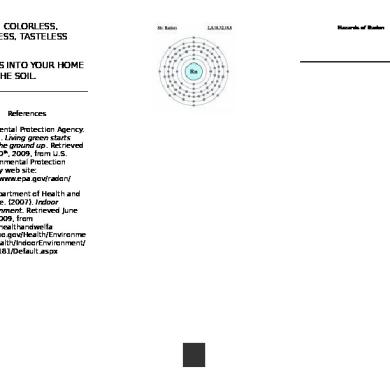Radon Brochure
This document was uploaded by user and they confirmed that they have the permission to share it. If you are author or own the copyright of this book, please report to us by using this DMCA report form. Report DMCA
Overview
Download & View Radon Brochure as PDF for free.
More details
- Words: 311
- Pages: 3
RADON: COLORLESS, ODORLESS, TASTELESS GAS. IT SEEPS INTO YOUR HOME FROM THE SOIL.
References Environmental Protection Agency. (2009). Living green starts from the ground up. Retrieved June 20th, 2009, from U.S. Environmental Protection Agency web site: http://www.epa.gov/radon/ Idaho Department of Health and Welfare. (2007). Indoor environment. Retrieved June 20th, 2009, from http://healthandwelfa re.idaho.gov/Health/Environme ntalHealth/IndoorEnvironment/ tabid/181/Default.aspx
Hazards of Radon
The Hazards of Radon
Informational Brochure
WHAT IS RADON? Facts 1.Radon
is an odorless, colorless, tasteless gas that seeps into the air from the soil
2.Radon
is the number one cause of lung cancer in non-smokers. 3.Radon
can be found everywhere in the world Radon comes from the breakdown of Uranium 4.
How does Radon enter your home?
Radon can enter through: -Crack and Gaps in floors, walls, and foundation -Construction Joints -Water Supply (Environmental Protection Agency, 2009.)
IDAHO Studies show approximately 37% of homes in Idaho have levels above the recommended range by the EPA.(Idaho Department of Health and Welfare, 2007)
TESTING YOUR HOME Everyone should test their home for Radon. There are two types of tests you can do on your home. - A short term test (3-7 days) -
A long term test (approx. 90 days).
-
Long term tests are more accurate
Radon Levels -Radon levels are measured in
picocuries/Liter of air = pCi/L -The EPA recommends levels of Radon to be below 4 pCi/L. -The average level of Radon in the outside air is 0.4 pCi/L. FIXING YOUR HOME If levels are above 4 pCi/L The EPA recommends you fix your home. -Ventilation systems can be installed in homes to filter the air from the soil to the outside of home -New homes can be built with these techniques already in place.
FREE TEST The Central District Health Department has a free short term test kit available to every household. http://cdhd.idaho.gov/E H/hazards/radon.htm It’s free! Test your home today!
References Environmental Protection Agency. (2009). Living green starts from the ground up. Retrieved June 20th, 2009, from U.S. Environmental Protection Agency web site: http://www.epa.gov/radon/ Idaho Department of Health and Welfare. (2007). Indoor environment. Retrieved June 20th, 2009, from http://healthandwelfa re.idaho.gov/Health/Environme ntalHealth/IndoorEnvironment/ tabid/181/Default.aspx
Hazards of Radon
The Hazards of Radon
Informational Brochure
WHAT IS RADON? Facts 1.Radon
is an odorless, colorless, tasteless gas that seeps into the air from the soil
2.Radon
is the number one cause of lung cancer in non-smokers. 3.Radon
can be found everywhere in the world Radon comes from the breakdown of Uranium 4.
How does Radon enter your home?
Radon can enter through: -Crack and Gaps in floors, walls, and foundation -Construction Joints -Water Supply (Environmental Protection Agency, 2009.)
IDAHO Studies show approximately 37% of homes in Idaho have levels above the recommended range by the EPA.(Idaho Department of Health and Welfare, 2007)
TESTING YOUR HOME Everyone should test their home for Radon. There are two types of tests you can do on your home. - A short term test (3-7 days) -
A long term test (approx. 90 days).
-
Long term tests are more accurate
Radon Levels -Radon levels are measured in
picocuries/Liter of air = pCi/L -The EPA recommends levels of Radon to be below 4 pCi/L. -The average level of Radon in the outside air is 0.4 pCi/L. FIXING YOUR HOME If levels are above 4 pCi/L The EPA recommends you fix your home. -Ventilation systems can be installed in homes to filter the air from the soil to the outside of home -New homes can be built with these techniques already in place.
FREE TEST The Central District Health Department has a free short term test kit available to every household. http://cdhd.idaho.gov/E H/hazards/radon.htm It’s free! Test your home today!
Related Documents

Radon Brochure
May 2020 1
Radon W Powietrzu
November 2019 5
Radon Gay Ung Thu Phoi
October 2019 1
Brochure
April 2020 44
Brochure
December 2019 80